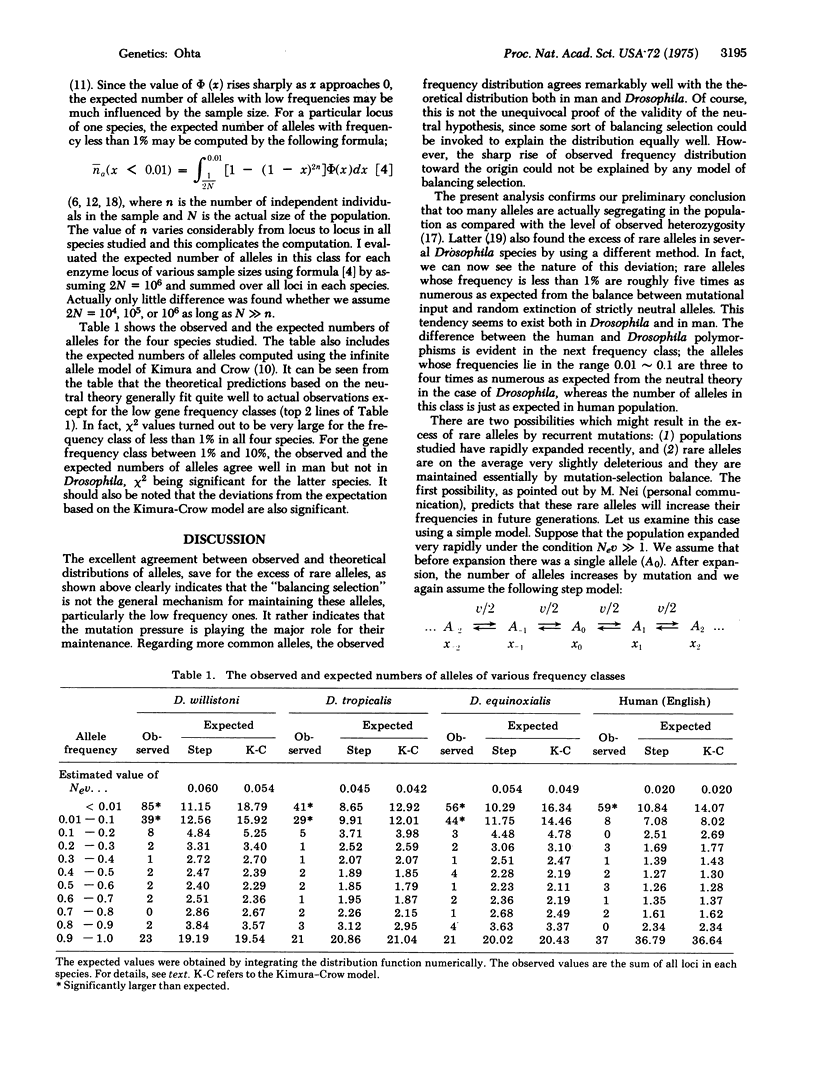Abstract
By using the distribution function of allelic frequencies which was recently derived by Kimura and Ota for the model of stepwise production of neutral alleles, the observed protein polymorphisms of Drosophila and man are tested for fit to the theory of neutral protein variation. The observed and theoretical distributions of alleles agree quite well except for the excess of rare alleles in the actual distributions. In human polymorphisms, the alleles with frequencies less than 1% are more numerous than expected, whereas in Drosophila, those with frequencies less than 10% are more numerous. It is pointed out that these results support my thesis that mutational pressure rather than balancing selection is the main cause for the maintenance of protein polymorphisms.
Full text
PDF


Selected References
These references are in PubMed. This may not be the complete list of references from this article.
- Ayala F. J., Tracey M. L., Barr L. G., McDonald J. F., Pérez-Salas S. Genetic variation in natural populations of five Drosophila species and the hypothesis of the selective neutrality of protein polymorphisms. Genetics. 1974 Jun;77(2):343–384. doi: 10.1093/genetics/77.2.343. [DOI] [PMC free article] [PubMed] [Google Scholar]
- Bernstein S. C., Throckmorton L. H., Hubby J. L. Still more genetic variability in natural populations. Proc Natl Acad Sci U S A. 1973 Dec;70(12):3928–3931. doi: 10.1073/pnas.70.12.3928. [DOI] [PMC free article] [PubMed] [Google Scholar]
- Ewens W. J. The sampling theory of selectively neutral alleles. Theor Popul Biol. 1972 Mar;3(1):87–112. doi: 10.1016/0040-5809(72)90035-4. [DOI] [PubMed] [Google Scholar]
- Harris H., Hopkinson D. A., Robson E. B. The incidence of rare alleles determining electrophoretic variants: data on 43 enzyme loci in man. Ann Hum Genet. 1974 Jan;37(3):237–253. doi: 10.1111/j.1469-1809.1974.tb01832.x. [DOI] [PubMed] [Google Scholar]
- Johnson G. B. Evidence that enzyme polymorphisms are not selectively neutral. Nat New Biol. 1972 Jun 7;237(75):170–171. doi: 10.1038/newbio237170a0. [DOI] [PubMed] [Google Scholar]
- Johnson G. B. On the estimation of effective number of alleles from electrophoretic data. Genetics. 1974 Oct;78(2):771–776. doi: 10.1093/genetics/78.2.771. [DOI] [PMC free article] [PubMed] [Google Scholar]
- KIMURA M., CROW J. F. THE NUMBER OF ALLELES THAT CAN BE MAINTAINED IN A FINITE POPULATION. Genetics. 1964 Apr;49:725–738. doi: 10.1093/genetics/49.4.725. [DOI] [PMC free article] [PubMed] [Google Scholar]
- Kimura M. Evolutionary rate at the molecular level. Nature. 1968 Feb 17;217(5129):624–626. doi: 10.1038/217624a0. [DOI] [PubMed] [Google Scholar]
- Kimura M., Ohta T. Distribution of allelic frequencies in a finite population under stepwise production of neutral alleles. Proc Natl Acad Sci U S A. 1975 Jul;72(7):2761–2764. doi: 10.1073/pnas.72.7.2761. [DOI] [PMC free article] [PubMed] [Google Scholar]
- Kimura M., Ohta T. Mutation and evolution at the molecular level. Genetics. 1973 Apr;73(Suppl):19–35. [PubMed] [Google Scholar]
- Kimura M., Ohta T. Protein polymorphism as a phase of molecular evolution. Nature. 1971 Feb 12;229(5285):467–469. doi: 10.1038/229467a0. [DOI] [PubMed] [Google Scholar]
- King J. L., Jukes T. H. Non-Darwinian evolution. Science. 1969 May 16;164(3881):788–798. doi: 10.1126/science.164.3881.788. [DOI] [PubMed] [Google Scholar]
- King J. L., Ohta T. Polyallelic mutational equilibria. Genetics. 1975 Apr;79(4):681–691. doi: 10.1093/genetics/79.4.681. [DOI] [PMC free article] [PubMed] [Google Scholar]
- Latter B. D. Enzyme polymorphisms: gene frequency distributions with mutation and selection for optimal activity. Genetics. 1975 Feb;79(2):325–331. doi: 10.1093/genetics/79.2.325. [DOI] [PMC free article] [PubMed] [Google Scholar]
- Nei M., Roychoudhury A. K. Sampling variances of heterozygosity and genetic distance. Genetics. 1974 Feb;76(2):379–390. doi: 10.1093/genetics/76.2.379. [DOI] [PMC free article] [PubMed] [Google Scholar]
- Ohta T., Kimura M. A model of mutation appropriate to estimate the number of electrophoretically detectable alleles in a finite population. Genet Res. 1973 Oct;22(2):201–204. doi: 10.1017/s0016672300012994. [DOI] [PubMed] [Google Scholar]
- Ohta T., Kimura M. Simulation studies on electrophoretically detectable genetic variability in a finite population. Genetics. 1974 Mar;76(3):615–624. doi: 10.1093/genetics/76.3.615. [DOI] [PMC free article] [PubMed] [Google Scholar]
- Ota T. Mutational pressure as the main cause of molecular evolution and polymorphism. Nature. 1974 Nov 29;252(5482):351–354. doi: 10.1038/252351a0. [DOI] [PubMed] [Google Scholar]
- Prakash S., Lewontin R. C., Hubby J. L. A molecular approach to the study of genic heterozygosity in natural populations. IV. Patterns of genic variation in central, marginal and isolated populations of Drosophila pseudoobscura. Genetics. 1969 Apr;61(4):841–858. doi: 10.1093/genetics/61.4.841. [DOI] [PMC free article] [PubMed] [Google Scholar]
- Yamazaki T., Maruyama T. Evidence for the neutral hypothesis of protein polymorphism. Science. 1972 Oct 6;178(4056):56–58. doi: 10.1126/science.178.4056.56. [DOI] [PubMed] [Google Scholar]


